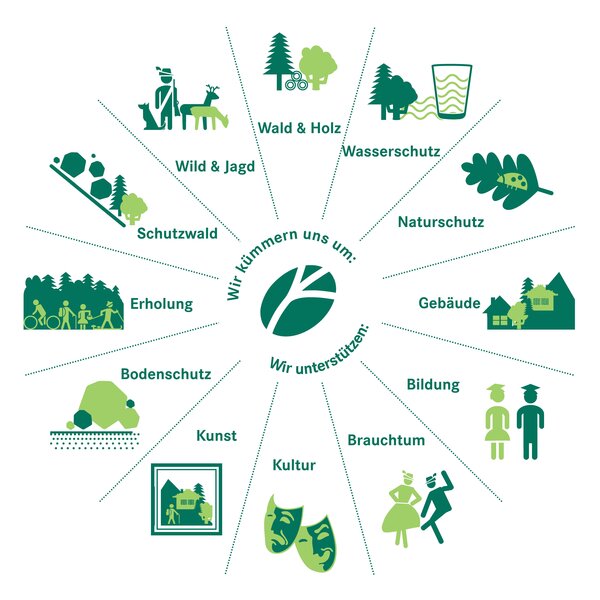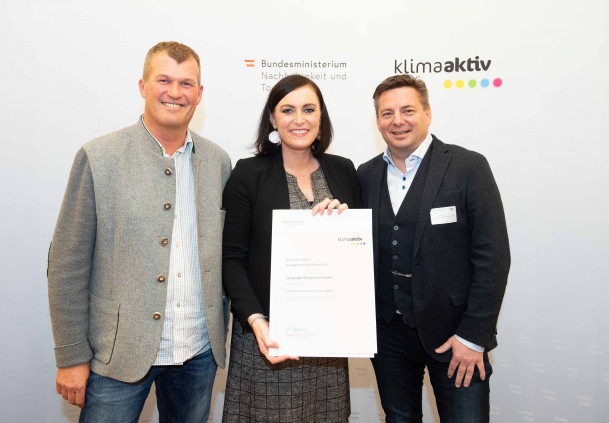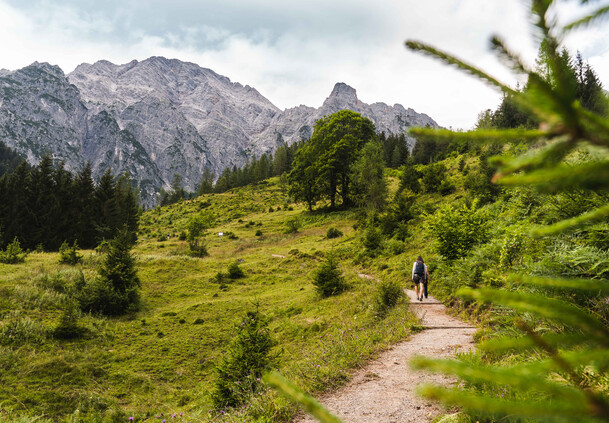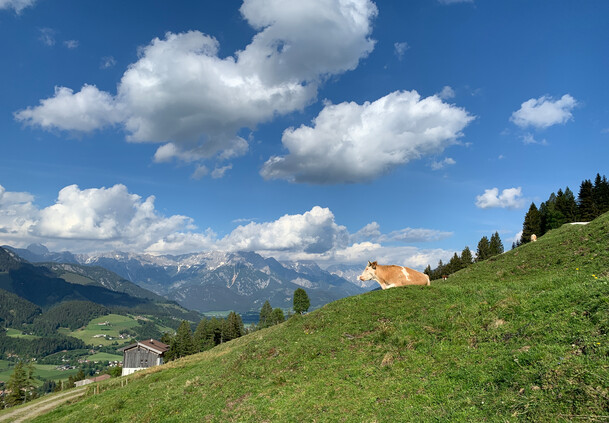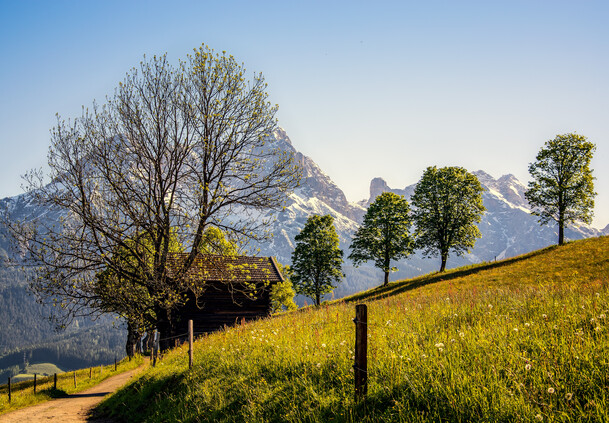Sustainably oriented Leoganger Bergbahnen
Can cable cars be sustainable?
Yes! For many years, Leoganger Bergbahnen has demonstrated that winter and summer sports can be enjoyed responsibly alongside the careful use of resources. Since 2006, we have consistently invested in energy efficiency, renewable energies, sustainable mobility and social projects, and we are gradually getting closer to our goal of becoming a mountain railway company that does not emit any greenhouse gases from its own activities.
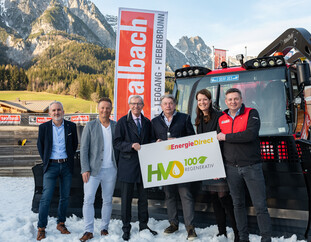
Sustainability has many facets!
For us, ecological, economic and social sustainability go hand in hand.
That is why we are implementing concrete measures in numerous areas:
- HVO100 throughout our entire vehicle fleet – virtually emission-free operation of snow groomers and vehicles
- 100% green electricity from regional sources (e.g. hydropower)
- Optimised snow-making and cable car systems to save energy
- Protection of sensitive habitats, e.g. the high moor on the Asitz and amphibian and low moor biotopes in the valley area
- Nature conservation compensation measures for infrastructure projects (e.g. new bike trails)
- Support for initiatives such as ‘Respect your boundaries’ to protect flora and fauna
- Waste prevention on the mountain – raising awareness, information on the ‘Berg der Sinne’ hiking map and a focus on personal responsibility instead of ‘rubbish collection’ in the great outdoors
- Clean the Trail Days & ‘Keep the Leogang Bike Park Clean’ – joint campaigns with the bike community to collect litter and raise awareness
We strive to be active in many areas:
In winter 2022/23, Leoganger Bergbahnen set itself the ambitious goal of reducing its emissions by more than 90% in a short period of time. Today, we have surpassed that target:
- In winter 2022/23, we emitted 605 tonnes of CO₂ internally.
- 24 tonnes in winter 2023/24.
- and less than 8 tonnes in winter 2024/25.
This means we have reduced our internal CO₂ emissions by 98.7% in just two winters.
The most important factor in this process was:
We completely converted our entire vehicle fleet – including snow groomers, company vehicles and tractors – to the renewable fuel HVO100. HVO100 is produced from renewable, biogenic waste products and enables a significant reduction in CO₂ emissions compared to fossil diesel.
The Leogang mountain railways are already powered entirely by green electricity. By converting our entire vehicle fleet to HVO100, we were able to reduce CO₂ emissions drastically in a very short time. This conversion had the greatest leverage effect in our decarbonisation strategy.'
– Kornel Grundner, Managing Director of Leoganger Bergbahnen
All figures and evaluations come from sustainable.de, a management consultancy specialising in sustainability with many years of expertise.
In Austria, the Climate Protection Act stipulates that the country should be greenhouse gas neutral by 2045. Leoganger Bergbahnen aims to achieve this much earlier. Our long-term goal is: No more emissions from our own activities.
To this end, we are focusing on the following, among other things:
- 100% green electricity for all cable cars and snow-making facilities
- Converting the entire vehicle fleet to HVO100.
- Ongoing efficiency improvements for snow-making and cable car facilities.
- heat recovery and intelligent energy use.
- Consistent review and optimisation by external experts.
The remaining emissions are primarily generated by biogenic energy sources for space heating (wood chip combined heat and power plant). We are also working on further optimisations in this area.
For us, sustainability is not a short-term trend, but has been strategically anchored for many years. Since 2006, Leoganger Bergbahnen has been investing in projects for energy efficiency, resource conservation and decarbonisation. These include, among others:
- Participation in the flagship project ‘Clean Energy For Tourism’ (CE4T) – focus topic: decarbonisation of winter tourism through intelligent energy management and digitalisation.
- Hydraulic and electrical optimisation of snow-making and cable car systems to significantly reduce energy consumption.
- Heat recovery from lift motors to heat operating rooms, workshops and the Stöcklalm mountain restaurant.
- Use of photovoltaics and modern drive technology, for example at the Asitzkogelbahn, with annual savings of several tens of thousands of kWh compared to older systems.
- Switch to district heating and use of regional energy sources.
For this commitment, Leoganger Bergbahnen has been awarded the ‘Umwelt Blatt Salzburg’ (Salzburg Environmental Award) and recognised by the Austrian Ministry of the Environment for its commitment to climate protection. Since 2019, we have also been the first ski resort to partner with the ‘Salzburg Climate and Energy Strategy 2050’.
Not only are the Leoganger Bergbahnen firmly anchored in sustainability, but the entire destination is too.
In 2023, Saalfelden Leogang became one of the first Austrian destinations to receive the Austrian Ecolabel for Destinations. This independent seal of approval assesses various factors, including:
- Sustainability and climate strategy
- waste disposal and management
Mobility and resource management.
It also considers the involvement of businesses, communities and the population.
The Leoganger Bergbahnen are a key partner in this development, being a Climate Alliance company and the first cable car partner of the 'Salzburg 2050 Climate and Energy Strategy', as well as making ongoing investments in sustainable infrastructure.

You will find further information on sustainability in Saalfelden Leogang here
A significant proportion of emissions in the tourism sector are generated during arrival and departure. In partnership with the Saalfelden Leogang region, we are dedicated to providing an extensive selection of eco-friendly travel alternatives:
- Guest Mobility Ticket (Pinzgau):
With your guest card, you can purchase the Guest Mobility Ticket at the Asitzbahn Information Centre and travel by bus and train throughout Pinzgau free of charge – ideal if you want to leave your car behind. More information can be found here. here.
- Loigom-Soifen Shuttle:
This on-demand shuttle complements the public transport network, offering flexible stops in Leogang with electric buses.
There are ski bus lines and regional bus services set up and supported by the mountain railways.
- There are 20 e-charging stations (including two fast chargers) at the valley stations of the Asitz and Steinberg cable cars. All information about the various charging options of Salzburg AG including instructions for use can be found here.

- LEO-mobil car sharing
Car sharing service offered by the municipality of Leogang with the support of Leoganger Bergbahnen and other partners – for businesses, employees and locals. https://loigom-hoit-zomm.at/leo-mobil/

As of this year, the Best Austrian Summer Mountain Lifts are co-operation partner of the KlimaTicket Austria.
All holders of a KlimaTicket Österreich receive a 10% discount at the ticket offices of our mountain lifts.
(10% discount on the ascent and/or descent from the current daily ticket price per person upon presentation of a valid KlimaTicket Österreich at the ticket office, not valid for online purchases, not valid on already reduced tickets).
Purpose of the collaboration
As part of the sustainability campaign of the Best Austrian Summer Mountain Lifts, "sustainable mobility" has been defined as one of the main priorities. One of our strengths lies here and we also have a high level of credibility as a mountain lift company. At the same time, however, the journey to the summer holiday destination is a major source of CO2 emissions. Travelling to the summer mountain destination is also possible in a climate-friendly way. In line with the motto "With the Climate Ticket + 100% electric mobility on the mountain railways, you can easily reach (almost) every summit and save money at the same time.
In 2004, the “Respektiere deine Grenzen” initiative was introduced, with the aim of systematically
creating extensive protection for sensitive habitats. To avoid people and nature treading on each other’s
toes, signs have been erected, clearly marking such areas. Flora and fauna thus not only have a voice,
but also the space that they actually need. The Leoganger Bergbahnen are making the public aware of
this project through all major media channels, and in doing so are promoting sustainability in nature.
The topic of the avoidance of rubbish in the mountains comes up again and again. Going under the
motto “whatever you take up the mountain, you have to bring back down”, in future more will be done
to make guests more aware of the issue. For example, all media channels will be used, including the
“Mountain of Senses” hiking map, to convey the message that there are no rubbish bins in the
mountains, because there can be no rubbish collection service.
Over the last year, the Leoganger Bergbahnen have placed emphasis on the topic of “waste separation”,
and carried the concept through from the mountains down into the valley. Every summer the biking community organises a joint campaign - find out more in the 'Clean the Trail Days' and 'Keep the Bikepark Leogang clean' sections.
- Continuous reduction of print runs.
- Use environmentally friendly, climate-neutral printing for unavoidable print types.
- Greater digitisation of guest information
- Home of the Lässig app
- Ongoing adaptation of production to actual demand.
Another measure taken to avoid rubbish in the mountains is the BikePark action “Roll-off not Tear-off”.
• Tear-offs (disposable plastic films for bike goggles) are not permitted in the BikePark.
• On rainy days, when bikers purchase a ticket, they are given a replacement film for a Roll-Off system and a 10% discount voucher for Roll-Off goggles in the sports shop at the bottom station.
Our “Clean the trail days" are a good example. On 3 days in the season, Bikepark visitors are invited,
together with the bike rescue team, bikes school guides, and Leogang Bike Club athletes, to clear all
rubbish from the lines and trails and surroundings. Lots of hard-working volunteers come to help comb
the area, collecting what doesn’t belong in nature, and enjoying some pizza together to end the day.
To us, sustainability also means taking responsibility for the region and its people. Examples of this include:
‘Loigom Holt Zomm’ – supporting the social association
Through fundraising campaigns related to our keycards and other initiatives, we provide people in need with quick and easy access to support.
Since 2018, Leoganger Bergbahnen has initiated a fundraising campaign every winter to support the association. The aim is to encourage people to donate the deposit for their ski pass on site after skiing. Donation boxes are located in many accommodation facilities and at the valley stations, making it very easy to donate – simply drop your keycard into the box to donate € 2.00!
“Loigom hoit zomm” (Leogang works together)
- For us, sustainability means treating nature and resources with care and taking social responsibility. Another example we would like to highlight here is:
A wonderful sign of solidarity: Hubert Eberhard, an employee of Leoganger Bergbahnen, donated part of his income to the Leogang bathhouse. To honour this commitment, Leoganger Bergbahnen topped up the amount to a total of € 1,000.Badhaus Leogang supports people with disabilities and creates space for an inclusive, diverse and vibrant community. With offerings such as inclusive holiday programmes, joint leisure activities, assisted communication and individual support, the facility promotes meaningful encounters and strengthens community spirit.
With this support, we are setting an example for social sustainability and promoting inclusive and diverse coexistence in our region.
During the donation ceremony, Kornel Grundner and Hubert Eberhard (from left to right) presented the cheque to Marcella Staberg from Badhaus Leogang.

The "Beste Österreichische Sommer-Bergbahn" (“Austria’s Best Summer Mountain Lifts”) strengthen
summer mountain tourism with their quality-tested offers and stand for sustainable regional
development. A special feature is the cooperative character - for over 20 years, they have been working
together to boost year-round tourism and employment.
In the "Think Tank" the innovative companies exchange themselves constantly in those topics.
Sustainable offers have become an important criterion for many guests when choosing their vacation
and are also actively demanded by employees. The Best Austrian Summer Mountain Railways also
consider it as their responsibility as a ropeway industry to create mountain experiences that stay in
harmony with the needs of nature, the environment and the region.
You can find out more about the defined sustainability goals and measures here.
The Bavarian “Saalforests” - St. Martin Forestry – Bavarian State Forests
The "Saalforste" is the name given to the Bavarian forests in Salzburg's Pinzgau region, which were once used for salt production in the Bad Reichenhall salt works. The wood was floated down the Saalach river and used for the boiling of salt in Reichenhall. The Bavarian Saalforests are a special feature of the Bavarian State Forests, as they are located in Austria.
As early as 1228, there was an agreement "wood for salt" between the Archbishop of Salzburg and the Duke of Bavaria and subsequently various other treaties. Most recently, the "Salt Works Convention" of 1829 - renewed in 1957 with the oldest state treaty still in force in Europe - regulated the following: "The Royal Bavarian Government is authorised to fell, harvest or export the sustainable timber yield of all its Saalforests without exception of any type of wood; to sell unmilled wood..." At the same time, in 1829/1957 Salzburg's salt mining on Berchtesgaden territory was regulated:
(Excerpt from the Salt Works Convention 1st Section, Art. 1) "... A mining area of the Hallein am Dürrnberg salt works has been designated to The Republic of Austria for the operation of salt mines on Bavarian territory..." "The Free State of Bavaria retains irrevocable ownership...
(List of land owned by Saalforest areas at the time of entry into force of the 1957 Convention)..."
The forests of the forestry company stretch between the Berchtesgaden High Alps in the east and the Chiemgau Mountains in the north to the central Alpine areas in Leogang in the south. The Bavarian State Forests maintain the forests according to the principle of "sustainable management". In times of climate change, the aim of the forestry operation is to create mixed mountain forests with a mix of tree species. These guarantee that three central tasks of the forestry operation are kept in balance: Firstly, the forest should be maintained in an exemplary manner and the habitat of rare animal and plant species should be protected and preserved. Secondly, the forest is for the people; for recreation and as a workplace for its own employees and workers in rural areas. Thirdly, the forestry operation of the Bavarian State Forests should be economically successful.
Some key forestry operation data
- Employees: 30
- Annual logging: 50,000 solid cubic metres
- Game hunted on around 15,300 hectares: 380 roe deer, 160 chamois, 130 red deer
Use – Protect – Recover:
Forestry makes a significant contribution to the value of the region through sustainable use of wood and its sale and use in the region.
Around 2/3 of the Saalforstwald forests are protected forests, which are extremely important for soil protection, water retention, avalanche protection and high-quality drinking water.
In the Leogang district, in close collaboration with the Leogang lift company and the tourism association, tourist use is also made possible on forestry land in addition to the core businesses of forestry and hunting and grazing rights. This means multiple use with mutual consideration in summer and winter on the slopes, with numerous downhill routes and forest tracks open to cyclists and numerous hiking trails.
The coniferous forests, which originate from the salt industry, consist mainly of spruce, fir and larch. The beech tree species was more common 1000 years ago, but as heavy wood it was problematic to transport it far and it burnt at too high a temperature for the brewing pans in Bad Reichenhall, where the salt was boiled.
In times of climate change, the Bavarian Saalforests are now once again introducing many mixed tree species, such as beech for example, in the make up of their forest stock as the average annual temperature in the region has increased by a good 2 degrees Celsius in the last 100 years and mixed forests are more stable and resistant than pure coniferous ones.
Company organisation: 1 forest manager, 1 service point manager, 4 employees in the office, 5 district managers (foresters), 2 professional hunters, 15 forest workers, 2 forestry masters
The raised bog in Leogang on the Kniestichkogel is located at an altitude of 1532 metres and covers an area of 5105 m². The peat mosses store rainwater like a sponge and keep the soil acidic. Species diversity in the raised bog is low because only specialised plants can cope with the acidic, constantly wet nutrient conditions. The raised bog grows about 1 millimetre per year, which is why a bog with a four-metre thick layer of peat is about 4000 years old. Protected bogs are important for climate protection because they store carbon dioxide. Digging in raised bog areas allows oxygen to enter the peat layers and mineralisation to begin. This breaks down the peat and turns it into humus. Carbon dioxide escapes. As a result of the oxygen input, the habitat is lost and cannot be restored. Degraded peatlands, e.g. those that have been drained, can be restored so that the remaining peat horizon does not decompose further. Such peatland restoration projects have become more common in recent years. This is partly due to the climate crisis and the ability of peatlands to store carbon. The raised bog 1 NO Asitz is protected under Section 24 of the Salzburg Nature Conservation Act, as amended, and the site is also protected under the Plant Protection Ordinance. This means that the habitat is fully protected and no intervention, i.e. construction or drainage of the area, is allowed. We see it as our duty to educate our guests about this special bog and to give environmental protection the importance it deserves in tourism.
There are two different types of biotope in the area between the Asitz and Steinberg valley stations. A biotope is defined as a habitat and the plant and animal species that live in it, regardless of whether it is dry or wet. This is a fen on the one hand and an amphibian biotope on the other. The fen occurs naturally on the site and the amphibian biotope was offered by Leoganger Bergbahnen as a compensatory measure in the course of a project realisation.
as a compensatory measure.
Why mitigation measures? In order to carry out interventions or projects in the open countryside, a nature conservation exemption permit must be obtained. An application to the competent authority initiates an inspection and negotiations with the responsible parties. During the negotiations, the project and the intervention are examined and it is decided whether a permit can be granted. The implementation of compensatory measures may be required for authorisation. Compensatory measures must result in a significant improvement to the landscape or ecosystem. For this purpose, a compensation calculation is carried out, as one third more compensation must be created than the impact. The Leoganger Bergbahnen have therefore received an exceptional nature conservation permit to compensate for the construction of a cycle path in the area and have implemented these two measures for this project.
The ‘Summit Charter’ of Österreichs Sommer Bergbahnen promotes conscious and sustainable behaviour in the mountains.
Under the motto ‘Together on the mountain’, it provides visitors with simple but effective rules for a responsible experience of nature.
Core principles of the charter:
- Preserve nature: Avoid littering and respect the environment.
- Enjoy safely: Be well prepared with the right equipment when out and about.
- Respect animals: Keep your distance from wild animals and keep dogs on a leash.
- Live mountain culture: Stay on the paths, close gates and park considerately.
The charter also contains important emergency numbers and contact information for cable cars in Austria.
The initiative appeals to all mountain visitors to make a positive contribution to the preservation of the alpine landscape through small gestures.Charta_Sommerbergbahn.pdf
Winter tourism plays a central role in Austria's economy and culture - also for us as Leoganger Bergbahnen.
Our mountains and pistes not only offer unforgettable experiences, but also make a significant contribution to regional value creation. At the same time, we are aware that this impressive backdrop and the infrastructure that makes it accessible can only be preserved with careful use of our natural resources.
OEW_Winter-Factsheet_Nachhaltigkeit.pdfOEW_Winter-Factsheet_Schneesicherheit.pdfOEW_Winter-Factsheet_Skiindustrie.pdfOEW_Winter-Factsheet_Skischulen.pdfOEW_Winter-Factsheet_Wertschoepfung.pdf
infografik-seilbahnen.pdfoesterreichs-seilbahnen-wissenswertes.pdfseilbahnen-und-energie-factsheet.pdfWertschöpfung Infographic Österreich neu.pdf
Numbers Data Facts
on winter tourism and sustainability
Contact for inquiries
Alice Messner
Tel: +43 / (0) 6583 / 8219 253
E-Mail: a.messner@leoganger-bergbahnen.at
L7 ASITZKOGELBAHN 8er
The latest construction project ASITZKOGELBAHN 8er (Asitzkogel lift 8er) replaced the sports lift in the Asitzmulde since winter 2022/23. Special attention was paid to the fact that the new technology of a direct drive and the new photovoltaic system will save a total of 62,000 kwh compared to the old system with the same transport.
More information about the Asitzkogel lift can be found here.










